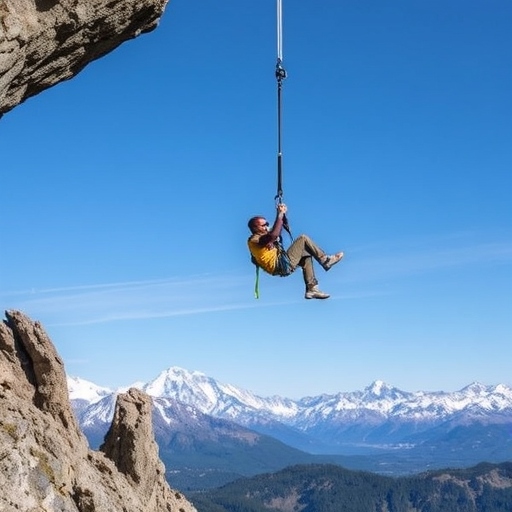Suspension trauma is a dangerous, life-threatening condition that can occur when a climber is suspended in their harness for too long, especially after a fall or unconsciousness. It’s a critical issue for rope solo climbers (TRS and LRS), as being left hanging without the ability to move can cause blood to pool in the legs and lower extremities, depriving the brain and vital organs of oxygen. Without prompt action, suspension trauma can quickly escalate to unconsciousness, organ failure, and death, sometimes in as little as 6 minutes.
What is Suspension Trauma?
Suspension trauma happens when a person is suspended upright for too long, with limited movement. Under normal conditions, muscle activity helps circulate blood throughout the body. However, when the body remains still in a harness, particularly in an upright position, the blood struggles to circulate properly. This results in blood pooling in the legs and a lack of oxygenated blood reaching vital organs, including the brain. For rope solo climbers, this becomes a serious risk if a fall leaves them hanging unconscious or immobile for an extended period. The condition can develop very quickly, with symptoms typically appearing within minutes. If left untreated, it can lead to unconsciousness, organ damage, and, in extreme cases, death.
Recognizing Suspension Trauma Symptoms
Early Symptoms Suspension trauma can strike quickly, and the initial symptoms can be subtle but important to recognize. These include:
- Dizziness or light-headedness
- Nausea
- Tingling or numbness in the arms and legs
- Anxiety or panic
- Visual disturbances
As the condition worsens, the victim may lose consciousness, and the body’s systems can begin to shut down. It’s essential to act quickly once these symptoms are noticed.
What to Do in an Emergency
For Conscious Victims If the victim is still conscious and suspended in their harness, the primary goal is to relieve pressure on the body and restore circulation. The person should be encouraged to move their limbs or take weight off the harness if possible:
- Stand on foot loops to relieve pressure.
- Seek a ledge or other support to help redistribute the weight.
This will help prevent the blood from pooling in the legs and keep oxygen flowing to the brain and vital organs. If moving isn’t possible, the victim should be lowered to a safe place as quickly as possible. For Unconscious Victims If the victim is unconscious or semi-conscious, immediate action is required:
- Lower the victim immediately to a safe location, ideally to the ground or a flat surface. A quick descent is crucial in preventing the progression of suspension trauma.
- Raise the legs: If you cannot lower the person right away, raising their legs above the level of their heart can help increase circulation back to the brain.
- Position the victim correctly: Lay them in the recovery position (on their side) to ensure the airway is clear and to prevent choking in case they vomit.
Get Medical Help Even after you manage to get the victim down and restore some normal circulation, seek medical attention immediately. Suspension trauma can cause long-term internal damage, so medical professionals should assess the individual as soon as possible.
Prevention and Preparedness for Rope Solo Climbers
For rope solo climbers (both TRS and LRS), suspension trauma is a real risk that requires proactive planning. While rope soloing, the absence of a partner means that you’re solely responsible for your own safety, including self-rescue if something goes wrong. Here are a few tips for minimizing the risk of suspension trauma and being prepared for emergencies:
- Know your limits: Be mindful of how long you’re hanging in your harness, and avoid prolonged suspension if possible.
- Practice self-rescue techniques: Familiarize yourself with ways to ascend back to your rope or adjust your position in case of a fall. Learn how to quickly set up a foot loop or make use of your gear to shift your weight.
- Carry appropriate rescue gear: Always have a rope, ascenders, and foot loops with you for self-rescue. Consider a load-releasable tether for emergency situations.
- Have a plan: Develop an emergency procedure for situations where you might be suspended for a prolonged period. Know how to rescue yourself or what actions to take in the event of an unconscious fall.
[2024-12-20 New Info!] About Overweight Climbers
We read in this informative article that not all climbers experience the same challenges when stranded in a sit harness. Overweight climbers, in particular, face a severe risk of suffocation and may succumb within minutes if not rescued. Sit harnesses can compress abdominal mass into the breathing space, leading to advanced suffocation symptoms almost immediately. To mitigate this, stranded climbers must either be quickly brought to firm ground or use an etrier, prusik loop, or a similar device to alleviate the pressure on their abdomen.
Final Thoughts
Suspension trauma is a deadly condition that can strike with alarming speed, particularly in rope solo climbing scenarios. In the event of a fall, it’s critical to recognize the symptoms early and act quickly to relieve the victim’s suspension and restore circulation. Whether you’re rope soloing or climbing with a partner, ensuring you have the right knowledge and gear can mean the difference between life and death. If you or a fellow climber experiences suspension trauma, remember: every second counts. React swiftly and don’t hesitate to call for medical assistance. And always remember, it can kill you in just 6 minutes.

